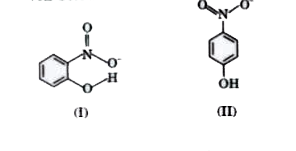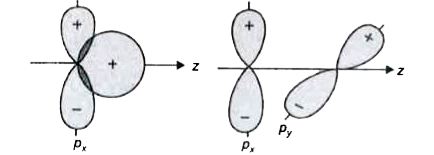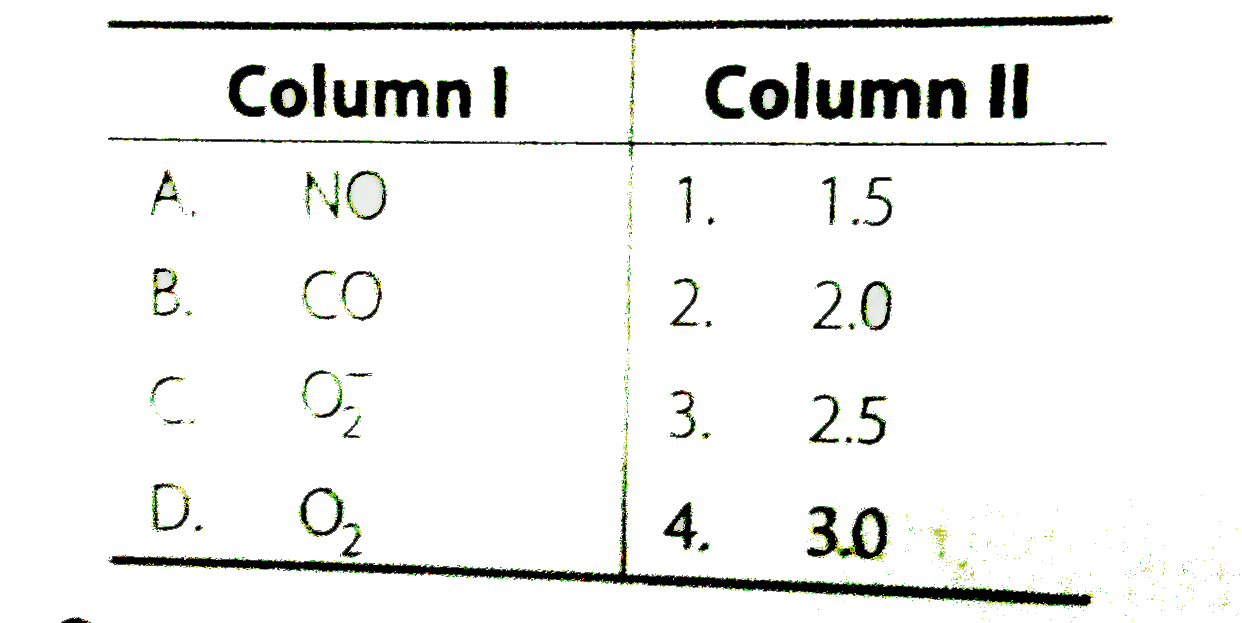NCERT (Exemplar Problems) (Matching Type Questions) from MODERN PUBLISHERS CHEMISTRY (HINGLISH) CHEMICAL BONDING AND MOLECULAR STRUCTURE for Class 11
| Class 11 | CHEMISTRY |
| Chapter | CHEMICAL BONDING AND MOLECULAR STRUCTURE |
| MODERN PUBLISHERS CHEMISTRY (HINGLISH) | NCERT (Exemplar Problems) (Matching Type Questions) |
| Medium | English |
| Academic Year | 2023-2024 |
Question 58
Comprehension given below is followed by some multiple choice question, Each question has one correct options. Choose the correct option.
Molecular orbitals are formed by the overlap of atomic orbitals. Two atomic orbitals combine to form two molecular orbitals called bonding molecular orbital (BMO) and anti-bonding molecular orbital (ABMO). Energy of anti-bonding orbital is raised above the parent atomic orbitals that have combined and hte energy of the bonding orbital is lowered than the parent atomic orbitals.
energies of various molecular orbitals for elements hydrogen to nitrogen increase in the order
σ1s<σ⋆1s<σ⋆2s<((π2px)=(π2py))<σ2pz<(π⋆2px=π⋆2py)<σ⋆2pz and For oxygen and fluorine order of enregy of molecules orbitals is given below.
σ1s<σ⋆1s<σ2s<σ⋆2s<σpz<(π2px≈π2py)<(π⋆2px≈π⋆2py)<σ⋆2pz
Different atomic orbitalsof one atom combine with those atoms orbitals of the second atom which have comparable energies and proper orientation.
Further, if the overlapping is head on, the molecular orbital is called sigma, σ andif the overlap is lateral, the molecular orbital is called pi, π. The molecular orbitals are filled with electrons according to the same rules as followed for filling of atomic orbitals.
However, the order for filling is not the same for all molecules or their ions. Bond order is one of the most important parameters to compare the strength of bonds.
67) Which of the following pair is expected to have the same bonod order?View SolutionQuestion 73
Structures of molecules of two compounds are given below :

(a) Which of the following compounds will have intermolecular hydrogen bonding and which compound is expected to show intramolecular hydrogen bonding?
(b) Which of the above two compounds will show higher melting point?
(c ) Which of the above compounds will form hydrogen bond with water easily and be more soluble in it? View SolutionQuestion 78
The energy of σ2pz, molecular orbital is greater than π2px and π2py molecular orbitals in nitrogen molecule. Write the complete sequence of energy levels in the increasing order of energy in the molecule. Compare the relative stability and the magnetic behaviour of the following species.
N2,N+2,N−2,N2+2View SolutionQuestion 104
Molecular orbitals are formed by the overlap of atomic orbitals. Two atomic called bonding molecular orbital (BMO) and anti - bonding molecular orbital (ABMO). Energy of anti - bonding molecular orbital (BMO) and anti - bonding molecular orbital ABMO). Energy of anti - bonding orbitals is raised above the parent atomic orbitals that have combined and the energy of the bonding orbital is lowered than the parent atomic orbitals. Energies of various molecular orbitals for elements hydrogen to nitrogen increase in the order : σ1s<σ∗1s<σ2s<σ∗2s<(π2px≈π2py)<σ2pz<(π∗p2px≈π∗2py)<σ∗2pz and for oxygen and fluorine order of energy of molecular orbitals is given as : σ1s<σ∗1s<σ2s<σ∗2s<σ2pz<(π2px≅2π2py)<(π∗2px≅π∗2py)<σ∗2pz. Different atomic orbitals of one atom combine with those atomic orbitals of the second atom which have comparable energies and proper orientation. Further, if the overlapping is head on, the molecular orbital is called 'sigma', (σ) and if the overlap is lateral, the molecular orbital is called 'pi', (π). The molecular orbitals are filled with electrons according to the same rules as followed for filling of atomic orbitals. However, the order for filling is not the same for all moleculas or their ions. Bond order is one of hte most important parameters to compare the strength of bonds.
Which of the following statements is correct?View SolutionQuestion 105
Molecular orbitals are formed by the overlap of atomic orbitals. Two atomic called bonding molecular orbital (BMO) and anti - bonding molecular orbital (ABMO). Energy of anti - bonding molecular orbital (BMO) and anti - bonding molecular orbital ABMO). Energy of anti - bonding orbitals is raised above the parent atomic orbitals that have combined and the energy of the bonding orbital is lowered than the parent atomic orbitals. Energies of various molecular orbitals for elements hydrogen to nitrogen increase in the order : σ1s<σ∗1s<σ2s<σ∗2s<(π2px≈π2py)<σ2pz<(π∗p2px≈π∗2py)<σ∗2pz and for oxygen and fluorine order of energy of molecular orbitals is given as : σ1s<σ∗1s<σ2s<σ∗2s<σ2pz<(π2px≅2π2py)<(π∗2px≅π∗2py)<σ∗2pz. Different atomic orbitals of one atom combine with those atomic orbitals of the second atom which have comparable energies and proper orientation. Further, if the overlapping is head on, the molecular orbital is called 'sigma', (σ) and if the overlap is lateral, the molecular orbital is called 'pi', (π). The molecular orbitals are filled with electrons according to the same rules as followed for filling of atomic orbitals. However, the order for filling is not the same for all moleculas or their ions. Bond order is one of hte most important parameters to compare the strength of bonds.
Which of the following molecular orbitals has maximum number of nodal planes?View SolutionQuestion 106
Molecular orbitals are formed by the overlap of atomic orbitals. Two atomic called bonding molecular orbital (BMO) and anti - bonding molecular orbital (ABMO). Energy of anti - bonding molecular orbital (BMO) and anti - bonding molecular orbital ABMO). Energy of anti - bonding orbitals is raised above the parent atomic orbitals that have combined and the energy of the bonding orbital is lowered than the parent atomic orbitals. Energies of various molecular orbitals for elements hydrogen to nitrogen increase in the order : σ1s<σ∗1s<σ2s<σ∗2s<(π2px≈π2py)<σ2pz<(π∗p2px≈π∗2py)<σ∗2pz and for oxygen and fluorine order of energy of molecular orbitals is given as : σ1s<σ∗1s<σ2s<σ∗2s<σ2pz<(π2px≅2π2py)<(π∗2px≅π∗2py)<σ∗2pz. Different atomic orbitals of one atom combine with those atomic orbitals of the second atom which have comparable energies and proper orientation. Further, if the overlapping is head on, the molecular orbital is called 'sigma', (σ) and if the overlap is lateral, the molecular orbital is called 'pi', (π). The molecular orbitals are filled with electrons according to the same rules as followed for filling of atomic orbitals. However, the order for filling is not the same for all moleculas or their ions. Bond order is one of hte most important parameters to compare the strength of bonds.
Which of the following pair is expected to have the same bond order?View SolutionQuestion 107
Molecular orbitals are formed by the overlap of atomic orbitals. Two atomic called bonding molecular orbital (BMO) and anti - bonding molecular orbital (ABMO). Energy of anti - bonding molecular orbital (BMO) and anti - bonding molecular orbital ABMO). Energy of anti - bonding orbitals is raised above the parent atomic orbitals that have combined and the energy of the bonding orbital is lowered than the parent atomic orbitals. Energies of various molecular orbitals for elements hydrogen to nitrogen increase in the order : σ1s<σ∗1s<σ2s<σ∗2s<(π2px≈π2py)<σ2pz<(π∗p2px≈π∗2py)<σ∗2pz and for oxygen and fluorine order of energy of molecular orbitals is given as : σ1s<σ∗1s<σ2s<σ∗2s<σ2pz<(π2px≅2π2py)<(π∗2px≅π∗2py)<σ∗2pz. Different atomic orbitals of one atom combine with those atomic orbitals of the second atom which have comparable energies and proper orientation. Further, if the overlapping is head on, the molecular orbital is called 'sigma', (σ) and if the overlap is lateral, the molecular orbital is called 'pi', (π). The molecular orbitals are filled with electrons according to the same rules as followed for filling of atomic orbitals. However, the order for filling is not the same for all moleculas or their ions. Bond order is one of hte most important parameters to compare the strength of bonds.
In which of the following molecules, σ2pz molecular orbital is filled after π2px and π2py molecular orbitals?View Solution
All Exercises from MODERN PUBLISHERS CHEMISTRY (HINGLISH) Class 11 CHEMISTRY CHEMICAL BONDING AND MOLECULAR STRUCTURE
- PRACTICE PROBLEMS
- EXERCISE
- PRACTICE PROBLEMS
- EXERCISE
- CONCEPTUAL QUESTIONS (1)
- CONCEPTUAL QUESTIONS (2)
- CONCEPTUAL QUESTIONS (3)
- CONCEPTUAL QUESTIONS (1)
- CONCEPTUAL QUESTIONS (2)
- CONCEPTUAL QUESTIONS (3)
- NCERT (EXEMPLAR PROBLEMS) (ASSERTION AND REASON TYPE QUESTIONS)
- NCERT (EXEMPLAR PROBLEMS) (LONG ANSWER QUESTIONS)
- NCERT (EXEMPLAR PROBLEMS) (MATCHING TYPE QUESTIONS)
- NCERT (EXEMPLAR PROBLEMS) (MCQ BASED ON GIVEN COMPREHENSION)
- NCERT (EXEMPLAR PROBLEMS) (MULTIPLE CHOICE QUESTIONS (TYPE-I))
- NCERT (EXEMPLAR PROBLEMS) (MULTIPLE CHOICE QUESTIONS (TYPE-II))
- NCERT (EXEMPLAR PROBLEMS) (SHORT ANSWER TYPE QUESTIONS)
- NCERT FILE (NCERT)(TEXTBOOK EXERCISES)
- NCERT (EXEMPLAR PROBLEMS) (ASSERTION AND REASON TYPE QUESTIONS)
- NCERT (EXEMPLAR PROBLEMS) (LONG ANSWER QUESTIONS)
- NCERT (EXEMPLAR PROBLEMS) (MATCHING TYPE QUESTIONS)
- NCERT (EXEMPLAR PROBLEMS) (MCQ BASED ON GIVEN COMPREHENSION)
- NCERT (EXEMPLAR PROBLEMS) (MULTIPLE CHOICE QUESTIONS (TYPE-I))
- NCERT (EXEMPLAR PROBLEMS) (MULTIPLE CHOICE QUESTIONS (TYPE-II))
- NCERT (EXEMPLAR PROBLEMS) (SHORT ANSWER TYPE QUESTIONS)
- NCERT FILE (NCERT)(TEXTBOOK EXERCISES)
- REVISION EXERCISES (OBJECTIVE QUESTIONS)(ASSERTION REASON QUESTIONS)
- REVISION EXERCISES (OBJECTIVE QUESTIONS)(FILL IN THE BLANKS QUESTIONS)
- REVISION EXERCISES (OBJECTIVE QUESTIONS)(LONG ANSWER QUESTIONS)
- REVISION EXERCISES (OBJECTIVE QUESTIONS)(PASSAGE BASED QUESTIONS)
- REVISION EXERCISES (OBJECTIVE QUESTIONS)(SHORT ANSWER QUESTIONS)
- REVISION EXERCISES (OBJECTIVE QUESTIONS)(SHORT ANSWER QUESTIONS)(FILL IN THE BLANKS: )
- REVISION EXERCISES (OBJECTIVE QUESTIONS)(TRUE OR FALSE QUESTIONS)
- REVISION EXERCISES (OBJECTIVE QUESTIONS)(VERY SHORT ANSWER QUESTIONS)
- REVISION EXERCISES (OBJECTIVE QUESTIONS)(ASSERTION REASON QUESTIONS)
- REVISION EXERCISES (OBJECTIVE QUESTIONS)(FILL IN THE BLANKS QUESTIONS)
- REVISION EXERCISES (OBJECTIVE QUESTIONS)(LONG ANSWER QUESTIONS)
- REVISION EXERCISES (OBJECTIVE QUESTIONS)(PASSAGE BASED QUESTIONS)
- REVISION EXERCISES (OBJECTIVE QUESTIONS)(SHORT ANSWER QUESTIONS)
- REVISION EXERCISES (OBJECTIVE QUESTIONS)(SHORT ANSWER QUESTIONS)(FILL IN THE BLANKS: )
- REVISION EXERCISES (OBJECTIVE QUESTIONS)(TRUE OR FALSE QUESTIONS)
- REVISION EXERCISES (OBJECTIVE QUESTIONS)(VERY SHORT ANSWER QUESTIONS)
- HIGHER ORDER THINKING SKILLS
- HIGHER ORDER THINKING SKILLS
- OBJECTIVE TYPE QUESTIONS (A. MULTIPLE CHOICE QUESTIONS)
- OBJECTIVE TYPE QUESTIONS (B. MULTIPLE CHOICE QUESTIONS)
- OBJECTIVE TYPE QUESTIONS (B. MULTIPLE CHOICE QUESTIONS) (JEE (ADVANCED) FOR IIT ENTRANCE)
- OBJECTIVE TYPE QUESTIONS (B. MULTIPLE CHOICE QUESTIONS) (JEE (MAIN) & OTHER STATE BOARDS FOR ENGINEERING ENTRANCE)
- OBJECTIVE TYPE QUESTIONS (C. MULTIPLE CHOICE QUESTIONS)
- OBJECTIVE TYPE QUESTIONS (D. MULTIPLE CHOICE QUESTIONS)
- OBJECTIVE TYPE QUESTIONS (D. MULTIPLE CHOICE QUESTIONS)(INTEGER TYPE QUESTIONS)
- OBJECTIVE TYPE QUESTIONS (D. MULTIPLE CHOICE QUESTIONS)(MATCHING TYPE QUESTION)
- OBJECTIVE TYPE QUESTIONS (D. MULTIPLE CHOICE QUESTIONS)(MATRIX MATCH TYPE QUESTION)
- OBJECTIVE TYPE QUESTIONS (A. MULTIPLE CHOICE QUESTIONS)
- OBJECTIVE TYPE QUESTIONS (B. MULTIPLE CHOICE QUESTIONS)
- OBJECTIVE TYPE QUESTIONS (B. MULTIPLE CHOICE QUESTIONS) (JEE (ADVANCED) FOR IIT ENTRANCE)
- OBJECTIVE TYPE QUESTIONS (B. MULTIPLE CHOICE QUESTIONS) (JEE (MAIN) & OTHER STATE BOARDS FOR ENGINEERING ENTRANCE)
- OBJECTIVE TYPE QUESTIONS (C. MULTIPLE CHOICE QUESTIONS)
- OBJECTIVE TYPE QUESTIONS (D. MULTIPLE CHOICE QUESTIONS)
- OBJECTIVE TYPE QUESTIONS (D. MULTIPLE CHOICE QUESTIONS)(INTEGER TYPE QUESTIONS)
- OBJECTIVE TYPE QUESTIONS (D. MULTIPLE CHOICE QUESTIONS)(MATCHING TYPE QUESTION)
- OBJECTIVE TYPE QUESTIONS (D. MULTIPLE CHOICE QUESTIONS)(MATRIX MATCH TYPE QUESTION)
- UNIT PRACTICE TEST
- UNIT PRACTICE TEST
- EXAMPLE
- EXAMPLE
- SOLVED EXAMPLES
- SOLVED EXAMPLES







